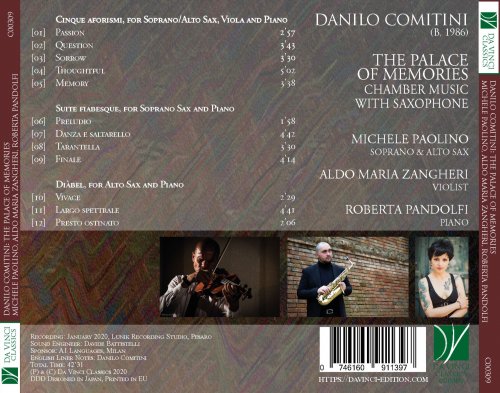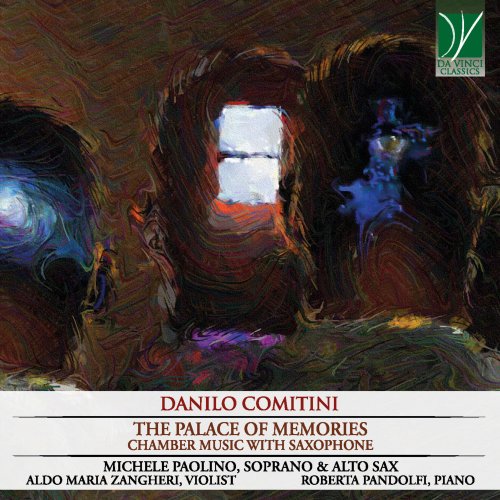
Aldo Maria Zangheri, Michele Paolino, Roberta Pandolfi - Danilo Comitini:The Palace of Memories (2020)
BAND/ARTIST: Aldo Maria Zangheri, Michele Paolino, Roberta Pandolfi
- Title: Danilo Comitini:The Palace of Memories
- Year Of Release: 2020
- Label: Da Vinci Classics
- Genre: Classical
- Quality: flac lossless
- Total Time: 00:42:30
- Total Size: 191 mb
- WebSite: Album Preview
Tracklist
01. Suite fiabesque I. Preludio (For Soprano Sax and Piano)
02. Suite fiabesque II. Danza e saltarello (For Soprano Sax and Piano)
03. Suite fiabesque III. Tarantella (For Soprano Sax and Piano)
04. Suite fiabesque IV. Finale (For Soprano Sax and Piano)
05. Cinque aforismi No. 1, Passion (For Soprano or Alto Sax, Viola and Piano)
06. Cinque aforismi No. 2, Question (For Soprano or Alto Sax, Viola and Piano)
07. Cinque aforismi No. 3, Sorrow (For Soprano or Alto Sax, Viola and Piano)
08. Cinque aforismi No. 4, Thoughtful (For Soprano or Alto Sax, Viola and Piano)
09. Cinque aforismi No. 5, Memory (For Soprano or Alto Sax, Viola and Piano)
10. Diabel I. Vivace (For Alto Sax and Piano)
11. Diabel II. Largo spettrale (For Alto Sax and Piano)
12. Diabel III. Presto ostinato (For Alto Sax and Piano)

Cinque aforismi
In a sort of “inner portrait”, the Cinque aforismi light up and focus on some of the most common emotinal aspects of man. Each aforism lives of its own life and is divided in a tripartite form, loaded with inner memory. Man is mirrored in the false dualism of the instruments, which reflect one silhouette only, alone with itself. The pages relive in a constant turning back which, alternating through joy and pain, is achieved in the “mirror” use of instruments and tonalities.
Suite fiabesque
Among the tiles of an ancient mosaic of dances, the “narrating voice” of the saxophone begins its tale. This is constantly changing and has multiple colours whose irridescence still amazes. The triple harmonic structure (diatonic tonal, chromatic tonal, modal) of the dances give the protagonist an equally varied timbre, richness that seems to want to imitate his closest family members. The Prelude opens the dances in a dense network of exchanges with the past (Rossini, La Cenerentola) and quickly leaves room for the dimension of the fairy tale which finds its maximum expression in the subsequent movement Danza and Saltarello, where melodiousness and rhythm are clearly contrasted. Tarantella represents the pinnacle of instrumental virtuosity and of the rhythmic component. From it, the Finale as a “dance of dances” is born without interruption.
Diàbeł
Diàbel (demon) approaches the Suite fiabesque for its rhythmic character and its own dance nature. The wide use of irregular meters invests the footsteps of a dancing demon with disorder and chaos, who is embodied in the piano struck with strength and nervousness and in an alto saxophone which, in addition to its virtuosic abilities, reveals its darkest voice and, bar after bar, he accompanies us sinking into hellish places. The Largo spettrale constitutes a momentary suspension of that inclined plane that will lead to Presto ostinato, the last whirling choreography of the underground pronist, before his final bow.
01. Suite fiabesque I. Preludio (For Soprano Sax and Piano)
02. Suite fiabesque II. Danza e saltarello (For Soprano Sax and Piano)
03. Suite fiabesque III. Tarantella (For Soprano Sax and Piano)
04. Suite fiabesque IV. Finale (For Soprano Sax and Piano)
05. Cinque aforismi No. 1, Passion (For Soprano or Alto Sax, Viola and Piano)
06. Cinque aforismi No. 2, Question (For Soprano or Alto Sax, Viola and Piano)
07. Cinque aforismi No. 3, Sorrow (For Soprano or Alto Sax, Viola and Piano)
08. Cinque aforismi No. 4, Thoughtful (For Soprano or Alto Sax, Viola and Piano)
09. Cinque aforismi No. 5, Memory (For Soprano or Alto Sax, Viola and Piano)
10. Diabel I. Vivace (For Alto Sax and Piano)
11. Diabel II. Largo spettrale (For Alto Sax and Piano)
12. Diabel III. Presto ostinato (For Alto Sax and Piano)

Cinque aforismi
In a sort of “inner portrait”, the Cinque aforismi light up and focus on some of the most common emotinal aspects of man. Each aforism lives of its own life and is divided in a tripartite form, loaded with inner memory. Man is mirrored in the false dualism of the instruments, which reflect one silhouette only, alone with itself. The pages relive in a constant turning back which, alternating through joy and pain, is achieved in the “mirror” use of instruments and tonalities.
Suite fiabesque
Among the tiles of an ancient mosaic of dances, the “narrating voice” of the saxophone begins its tale. This is constantly changing and has multiple colours whose irridescence still amazes. The triple harmonic structure (diatonic tonal, chromatic tonal, modal) of the dances give the protagonist an equally varied timbre, richness that seems to want to imitate his closest family members. The Prelude opens the dances in a dense network of exchanges with the past (Rossini, La Cenerentola) and quickly leaves room for the dimension of the fairy tale which finds its maximum expression in the subsequent movement Danza and Saltarello, where melodiousness and rhythm are clearly contrasted. Tarantella represents the pinnacle of instrumental virtuosity and of the rhythmic component. From it, the Finale as a “dance of dances” is born without interruption.
Diàbeł
Diàbel (demon) approaches the Suite fiabesque for its rhythmic character and its own dance nature. The wide use of irregular meters invests the footsteps of a dancing demon with disorder and chaos, who is embodied in the piano struck with strength and nervousness and in an alto saxophone which, in addition to its virtuosic abilities, reveals its darkest voice and, bar after bar, he accompanies us sinking into hellish places. The Largo spettrale constitutes a momentary suspension of that inclined plane that will lead to Presto ostinato, the last whirling choreography of the underground pronist, before his final bow.
Year 2020 | Classical | FLAC / APE
As a ISRA.CLOUD's PREMIUM member you will have the following benefits:
- Unlimited high speed downloads
- Download directly without waiting time
- Unlimited parallel downloads
- Support for download accelerators
- No advertising
- Resume broken downloads


